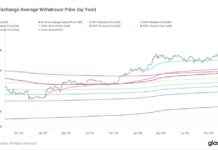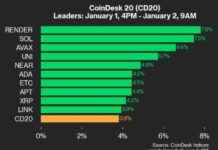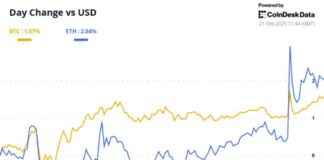The recent shift in Bitcoin’s key indicator signals a potential bearish trend, coinciding with President Donald Trump’s tariff rhetoric that could impact market stability. Published on February 10, 2025, at 6:48 a.m. UTC, this development has caught the attention of investors and analysts alike.
The moving average convergence divergence (MACD) histogram, a crucial tool used to assess trend strength and changes, has now turned negative on Bitcoin’s weekly chart. This shift is a significant departure from the positive momentum that fueled Bitcoin’s post-election price surge. While the MACD crossing below zero typically indicates a bearish trend, it’s essential to exercise caution and not panic prematurely.
Understanding the MACD Indicator
The MACD histogram is a technical indicator calculated by subtracting Bitcoin’s average price over the past 26 periods from the average over the past 12 weeks. The resulting signal line, derived from a nine-week average of the MACD, is plotted as a histogram. Crossovers above zero signal a bullish trend, while those below zero suggest a bearish shift in momentum.
In mid-October, the MACD indicator turned positive, fueling optimism for a potential rally to $100,000. However, recent developments have seen the indicator take a negative turn, sparking concerns among retail buyers who rely heavily on technical analysis tools for investment decisions.
Despite the bearish signal, Bitcoin’s current price action does not fully validate the MACD’s negative reading. The cryptocurrency remains within a range of $90,000 to $100,000, with recent fluctuations narrowing to $95,000 to $100,000. The lack of a clear trend diminishes the significance of the MACD’s bearish crossover, highlighting the need for caution when interpreting technical indicators.
Macroeconomic Factors at Play
While the MACD signal is cause for attention, several macro factors could introduce downside volatility into the market, potentially testing Bitcoin’s support levels near $90,000. President Trump’s tariff rhetoric, particularly his announcement of impending tariffs on steel and aluminum imports, has raised concerns about higher bond yields and lower risk assets.
The University of Michigan’s consumer sentiment survey revealed that the tariff threat is already impacting consumer expectations of inflation. Inflation expectations for the upcoming year surged to 4.3% in February from 3.3% in January, marking the highest reading since November 2023. This inflationary pressure could deter the Federal Reserve from rapid rate cuts, influencing market dynamics.
Alfonso Peccatiello, the author of Macro Compass, highlighted the market’s interpretation of the Fed’s stance on potential rate cuts in response to inflationary pressures. The upcoming U.S. CPI data release scheduled for February 12 will provide further insights into consumer price trends and their implications for monetary policy.
In conclusion, while the bearish MACD signal and external macroeconomic factors present challenges for Bitcoin’s price trajectory, caution and vigilance are essential for navigating these uncertain times. As the market continues to evolve, investors and traders must remain adaptable and informed to make well-informed decisions in the ever-changing landscape of cryptocurrency trading.


















